FIAT 500 2020 Owner handbook (in English)
Manufacturer: FIAT, Model Year: 2020, Model line: 500, Model: FIAT 500 2020Pages: 228, PDF Size: 6.01 MB
Page 91 of 228
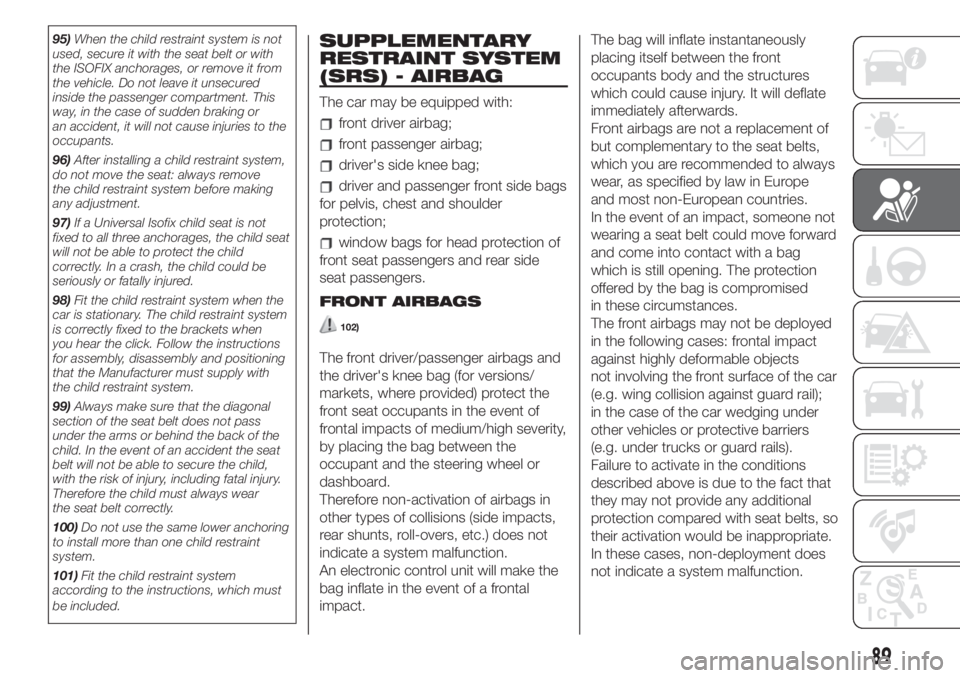
95)When the child restraint system is not
used, secure it with the seat belt or with
the ISOFIX anchorages, or remove it from
the vehicle. Do not leave it unsecured
inside the passenger compartment. This
way, in the case of sudden braking or
an accident, it will not cause injuries to the
occupants.
96)After installing a child restraint system,
do not move the seat: always remove
the child restraint system before making
any adjustment.
97)If a Universal Isofix child seat is not
fixed to all three anchorages, the child seat
will not be able to protect the child
correctly. In a crash, the child could be
seriously or fatally injured.
98)Fit the child restraint system when the
car is stationary. The child restraint system
is correctly fixed to the brackets when
you hear the click. Follow the instructions
for assembly, disassembly and positioning
that the Manufacturer must supply with
the child restraint system.
99)Always make sure that the diagonal
section of the seat belt does not pass
under the arms or behind the back of the
child. In the event of an accident the seat
belt will not be able to secure the child,
with the risk of injury, including fatal injury.
Therefore the child must always wear
the seat belt correctly.
100)Do not use the same lower anchoring
to install more than one child restraint
system.
101)Fit the child restraint system
according to the instructions, which must
be included.SUPPLEMENTARY
RESTRAINT SYSTEM
(SRS) - AIRBAG
The car may be equipped with:
front driver airbag;
front passenger airbag;
driver's side knee bag;
driver and passenger front side bags
for pelvis, chest and shoulder
protection;
window bags for head protection of
front seat passengers and rear side
seat passengers.
FRONT AIRBAGS
102)
The front driver/passenger airbags and
the driver's knee bag (for versions/
markets, where provided) protect the
front seat occupants in the event of
frontal impacts of medium/high severity,
by placing the bag between the
occupant and the steering wheel or
dashboard.
Therefore non-activation of airbags in
other types of collisions (side impacts,
rear shunts, roll-overs, etc.) does not
indicate a system malfunction.
An electronic control unit will make the
bag inflate in the event of a frontal
impact.The bag will inflate instantaneously
placing itself between the front
occupants body and the structures
which could cause injury. It will deflate
immediately afterwards.
Front airbags are not a replacement of
but complementary to the seat belts,
which you are recommended to always
wear, as specified by law in Europe
and most non-European countries.
In the event of an impact, someone not
wearing a seat belt could move forward
and come into contact with a bag
which is still opening. The protection
offered by the bag is compromised
in these circumstances.
The front airbags may not be deployed
in the following cases: frontal impact
against highly deformable objects
not involving the front surface of the car
(e.g. wing collision against guard rail);
in the case of the car wedging under
other vehicles or protective barriers
(e.g. under trucks or guard rails).
Failure to activate in the conditions
described above is due to the fact that
they may not provide any additional
protection compared with seat belts, so
their activation would be inappropriate.
In these cases, non-deployment does
not indicate a system malfunction.
89
Page 92 of 228
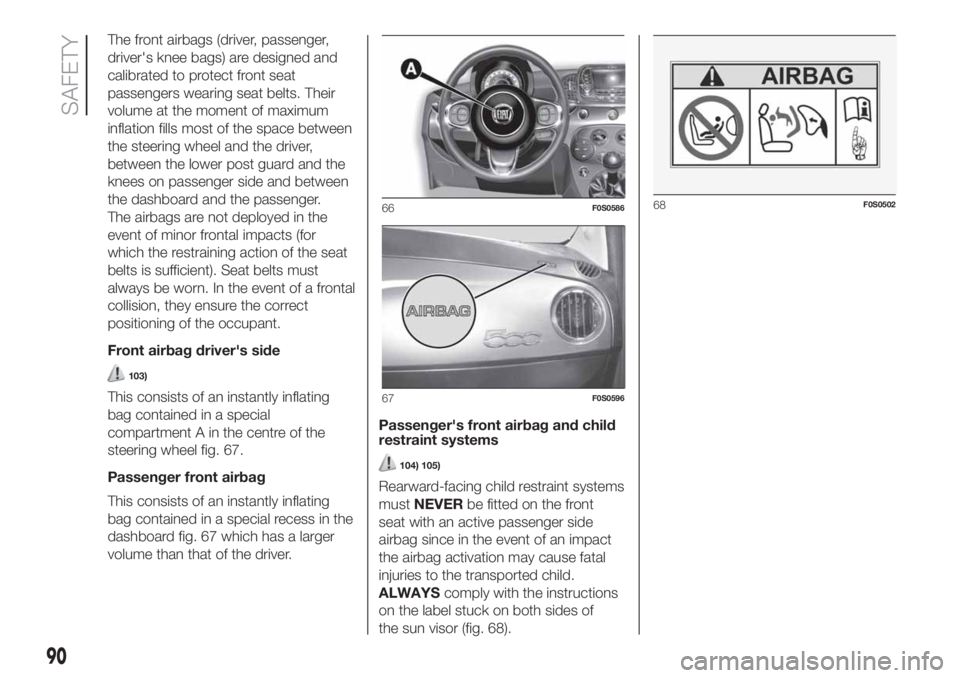
The front airbags (driver, passenger,
driver's knee bags) are designed and
calibrated to protect front seat
passengers wearing seat belts. Their
volume at the moment of maximum
inflation fills most of the space between
the steering wheel and the driver,
between the lower post guard and the
knees on passenger side and between
the dashboard and the passenger.
The airbags are not deployed in the
event of minor frontal impacts (for
which the restraining action of the seat
belts is sufficient). Seat belts must
always be worn. In the event of a frontal
collision, they ensure the correct
positioning of the occupant.
Front airbag driver's side
103)
This consists of an instantly inflating
bag contained in a special
compartment A in the centre of the
steering wheel fig. 67.
Passenger front airbag
This consists of an instantly inflating
bag contained in a special recess in the
dashboard fig. 67 which has a larger
volume than that of the driver.Passenger's front airbag and child
restraint systems
104) 105)
Rearward-facing child restraint systems
mustNEVERbe fitted on the front
seat with an active passenger side
airbag since in the event of an impact
the airbag activation may cause fatal
injuries to the transported child.
ALWAYScomply with the instructions
on the label stuck on both sides of
the sun visor (fig. 68).
66F0S0586
67F0S0596
68F0S0502
90
SAFETY
Page 93 of 228
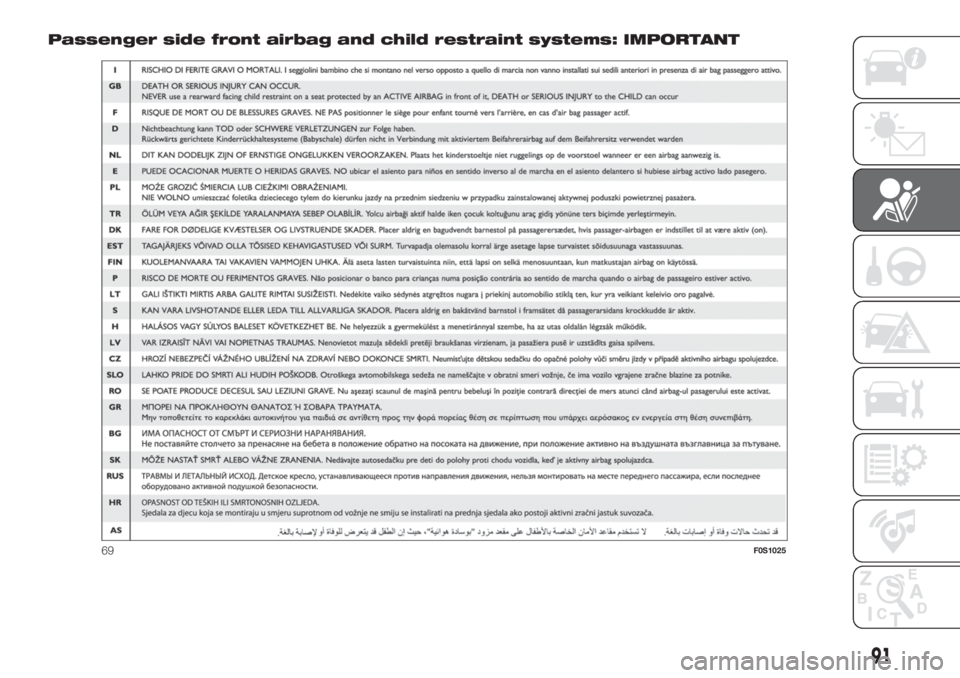
Passenger side front airbag and child restraint systems: IMPORTANT
69F0S1025
91
Page 94 of 228
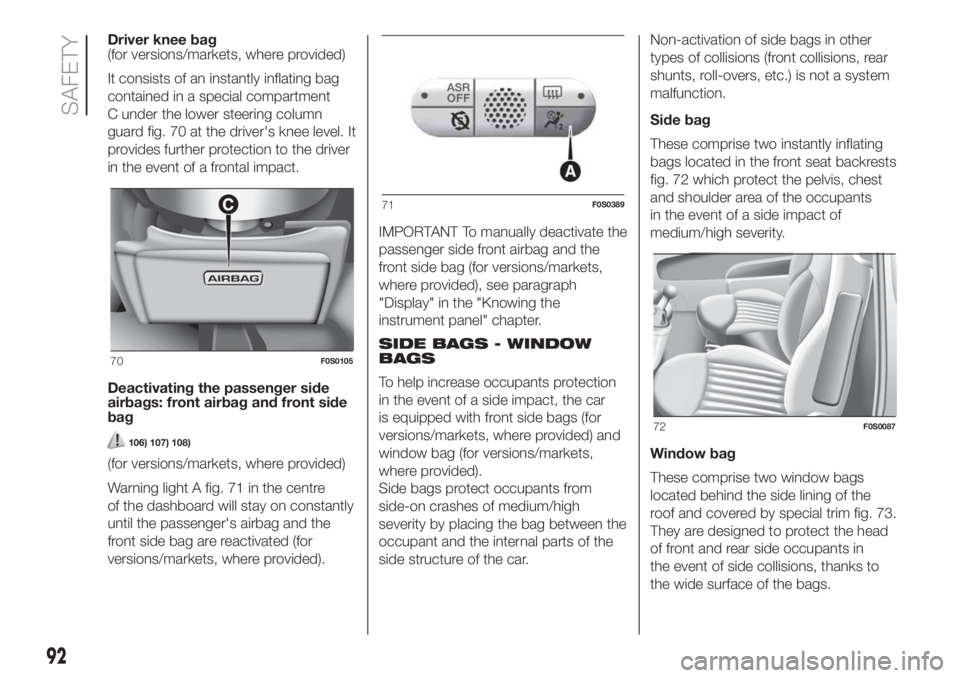
Driver knee bag
(for versions/markets, where provided)
It consists of an instantly inflating bag
contained in a special compartment
C under the lower steering column
guard fig. 70 at the driver's knee level. It
provides further protection to the driver
in the event of a frontal impact.
Deactivating the passenger side
airbags: front airbag and front side
bag
106) 107) 108)
(for versions/markets, where provided)
Warning light A fig. 71 in the centre
of the dashboard will stay on constantly
until the passenger's airbag and the
front side bag are reactivated (for
versions/markets, where provided).IMPORTANT To manually deactivate the
passenger side front airbag and the
front side bag (for versions/markets,
where provided), see paragraph
"Display" in the "Knowing the
instrument panel" chapter.
SIDE BAGS - WINDOW
BAGS
To help increase occupants protection
in the event of a side impact, the car
is equipped with front side bags (for
versions/markets, where provided) and
window bag (for versions/markets,
where provided).
Side bags protect occupants from
side-on crashes of medium/high
severity by placing the bag between the
occupant and the internal parts of the
side structure of the car.Non-activation of side bags in other
types of collisions (front collisions, rear
shunts, roll-overs, etc.) is not a system
malfunction.
Side bag
These comprise two instantly inflating
bags located in the front seat backrests
fig. 72 which protect the pelvis, chest
and shoulder area of the occupants
in the event of a side impact of
medium/high severity.
Window bag
These comprise two window bags
located behind the side lining of the
roof and covered by special trim fig. 73.
They are designed to protect the head
of front and rear side occupants in
the event of side collisions, thanks to
the wide surface of the bags.
70F0S0105
71F0S0389
72F0S0087
92
SAFETY
Page 95 of 228
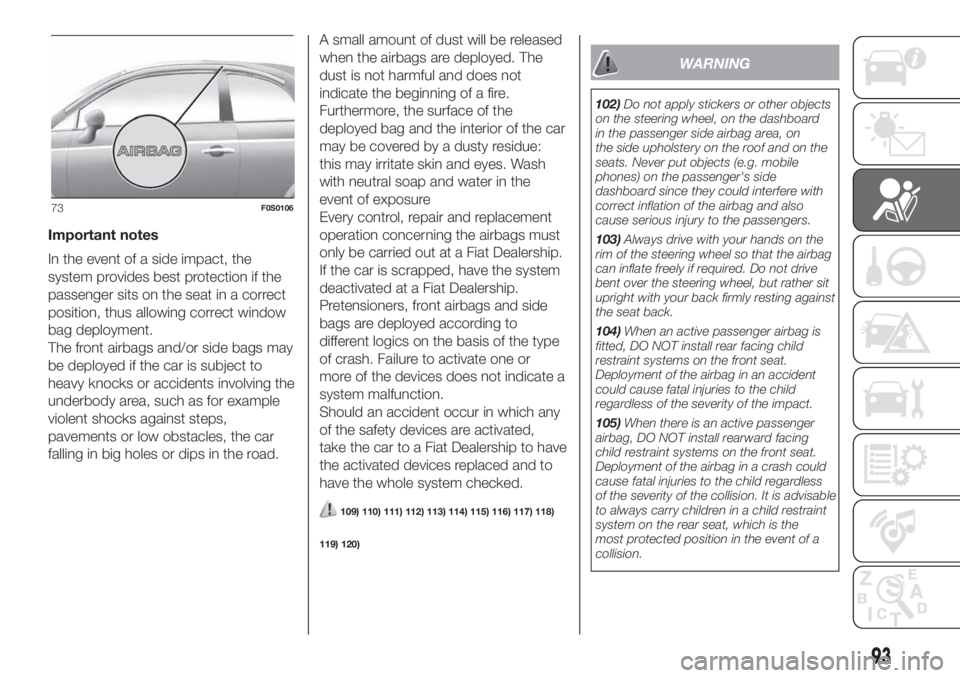
Important notes
In the event of a side impact, the
system provides best protection if the
passenger sits on the seat in a correct
position, thus allowing correct window
bag deployment.
The front airbags and/or side bags may
be deployed if the car is subject to
heavy knocks or accidents involving the
underbody area, such as for example
violent shocks against steps,
pavements or low obstacles, the car
falling in big holes or dips in the road.A small amount of dust will be released
when the airbags are deployed. The
dust is not harmful and does not
indicate the beginning of a fire.
Furthermore, the surface of the
deployed bag and the interior of the car
may be covered by a dusty residue:
this may irritate skin and eyes. Wash
with neutral soap and water in the
event of exposure
Every control, repair and replacement
operation concerning the airbags must
only be carried out at a Fiat Dealership.
If the car is scrapped, have the system
deactivated at a Fiat Dealership.
Pretensioners, front airbags and side
bags are deployed according to
different logics on the basis of the type
of crash. Failure to activate one or
more of the devices does not indicate a
system malfunction.
Should an accident occur in which any
of the safety devices are activated,
take the car to a Fiat Dealership to have
the activated devices replaced and to
have the whole system checked.
109) 110) 111) 112) 113) 114) 115) 116) 117) 118)
119) 120)
WARNING
102)Do not apply stickers or other objects
on the steering wheel, on the dashboard
in the passenger side airbag area, on
the side upholstery on the roof and on the
seats. Never put objects (e.g. mobile
phones) on the passenger's side
dashboard since they could interfere with
correct inflation of the airbag and also
cause serious injury to the passengers.
103)Always drive with your hands on the
rim of the steering wheel so that the airbag
can inflate freely if required. Do not drive
bent over the steering wheel, but rather sit
upright with your back firmly resting against
the seat back.
104)When an active passenger airbag is
fitted, DO NOT install rear facing child
restraint systems on the front seat.
Deployment of the airbag in an accident
could cause fatal injuries to the child
regardless of the severity of the impact.
105)When there is an active passenger
airbag, DO NOT install rearward facing
child restraint systems on the front seat.
Deployment of the airbag in a crash could
cause fatal injuries to the child regardless
of the severity of the collision. It is advisable
to always carry children in a child restraint
system on the rear seat, which is the
most protected position in the event of a
collision.
73F0S0106
93
Page 96 of 228
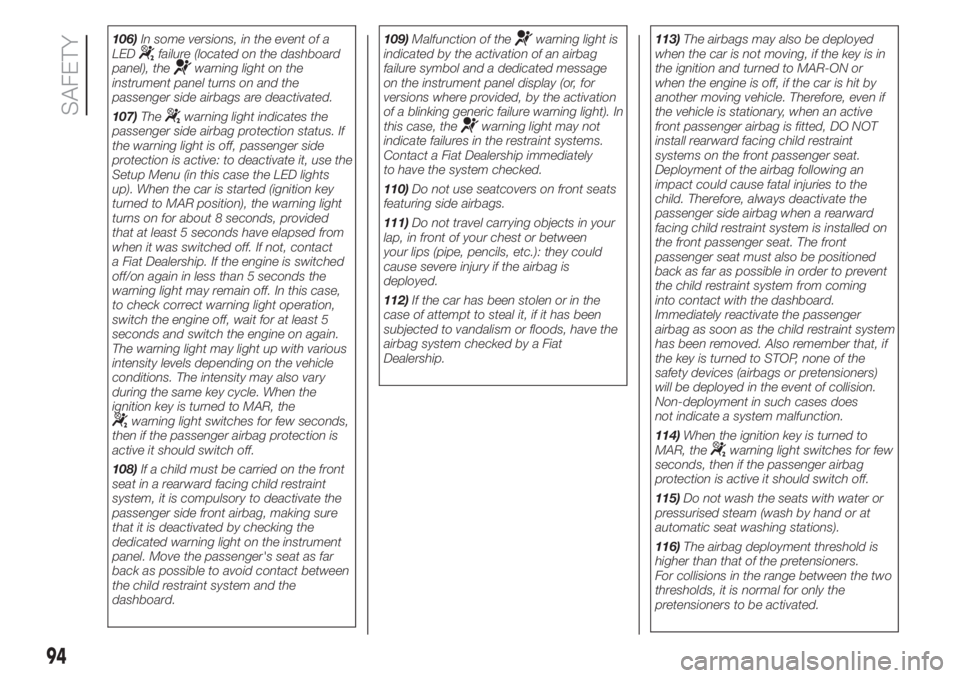
106)In some versions, in the event of a
LEDfailure (located on the dashboard
panel), thewarning light on the
instrument panel turns on and the
passenger side airbags are deactivated.
107)The
warning light indicates the
passenger side airbag protection status. If
the warning light is off, passenger side
protection is active: to deactivate it, use the
Setup Menu (in this case the LED lights
up). When the car is started (ignition key
turned to MAR position), the warning light
turns on for about 8 seconds, provided
that at least 5 seconds have elapsed from
when it was switched off. If not, contact
a Fiat Dealership. If the engine is switched
off/on again in less than 5 seconds the
warning light may remain off. In this case,
to check correct warning light operation,
switch the engine off, wait for at least 5
seconds and switch the engine on again.
The warning light may light up with various
intensity levels depending on the vehicle
conditions. The intensity may also vary
during the same key cycle. When the
ignition key is turned to MAR, the
warning light switches for few seconds,
then if the passenger airbag protection is
active it should switch off.
108)If a child must be carried on the front
seat in a rearward facing child restraint
system, it is compulsory to deactivate the
passenger side front airbag, making sure
that it is deactivated by checking the
dedicated warning light on the instrument
panel. Move the passenger's seat as far
back as possible to avoid contact between
the child restraint system and the
dashboard.109)Malfunction of the
warning light is
indicated by the activation of an airbag
failure symbol and a dedicated message
on the instrument panel display (or, for
versions where provided, by the activation
of a blinking generic failure warning light). In
this case, the
warning light may not
indicate failures in the restraint systems.
Contact a Fiat Dealership immediately
to have the system checked.
110)Do not use seatcovers on front seats
featuring side airbags.
111)Do not travel carrying objects in your
lap, in front of your chest or between
your lips (pipe, pencils, etc.): they could
cause severe injury if the airbag is
deployed.
112)If the car has been stolen or in the
case of attempt to steal it, if it has been
subjected to vandalism or floods, have the
airbag system checked by a Fiat
Dealership.113)The airbags may also be deployed
when the car is not moving, if the key is in
the ignition and turned to MAR-ON or
when the engine is off, if the car is hit by
another moving vehicle. Therefore, even if
the vehicle is stationary, when an active
front passenger airbag is fitted, DO NOT
install rearward facing child restraint
systems on the front passenger seat.
Deployment of the airbag following an
impact could cause fatal injuries to the
child. Therefore, always deactivate the
passenger side airbag when a rearward
facing child restraint system is installed on
the front passenger seat. The front
passenger seat must also be positioned
back as far as possible in order to prevent
the child restraint system from coming
into contact with the dashboard.
Immediately reactivate the passenger
airbag as soon as the child restraint system
has been removed. Also remember that, if
the key is turned to STOP, none of the
safety devices (airbags or pretensioners)
will be deployed in the event of collision.
Non-deployment in such cases does
not indicate a system malfunction.
114)When the ignition key is turned to
MAR, the
warning light switches for few
seconds, then if the passenger airbag
protection is active it should switch off.
115)Do not wash the seats with water or
pressurised steam (wash by hand or at
automatic seat washing stations).
116)The airbag deployment threshold is
higher than that of the pretensioners.
For collisions in the range between the two
thresholds, it is normal for only the
pretensioners to be activated.
94
SAFETY
Page 97 of 228

117)Do not affix rigid objects to the
garment hooks or support handles.
118)The airbag does not replace seat
belts but increases their efficiency.
Furthermore, since front airbags are not
deployed in low-speed frontal impacts,
side impacts, rear shunts or roll-overs, the
passengers are protected only by the
seat belts which must therefore be
fastened at all times.
119)Do not rest your head, arms or
elbows on the door, windows or the area in
which the window bag is located to avoid
possible injury during airbag inflation.
120)Never lean your head, arms or elbows
out of the window.
95
Page 98 of 228
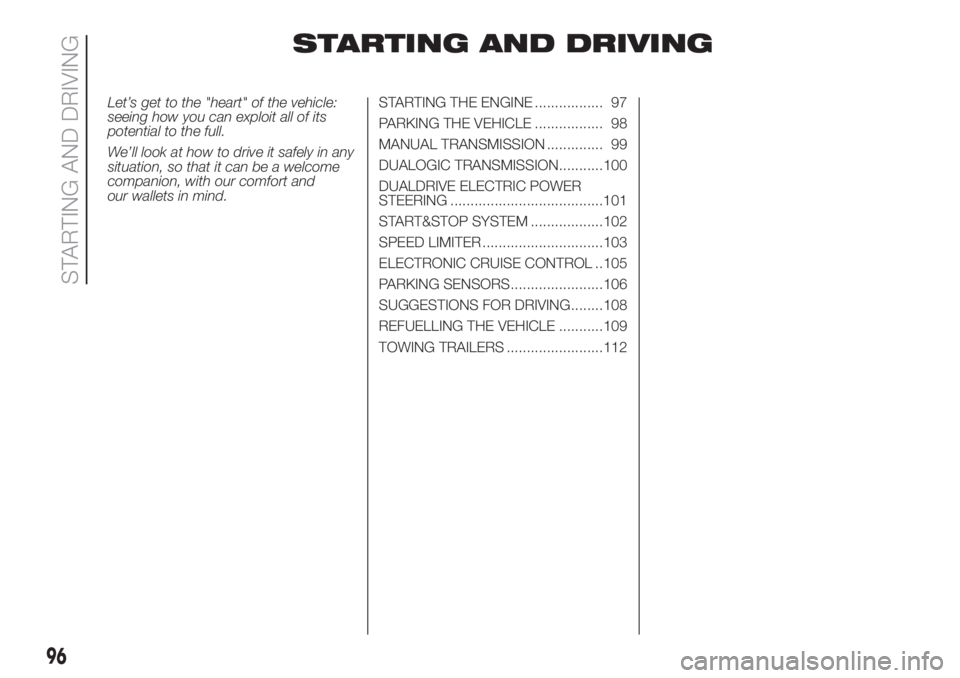
STARTING AND DRIVING
Let’s get to the "heart" of the vehicle:
seeing how you can exploit all of its
potential to the full.
We’ll look at how to drive it safely in any
situation, so that it can be a welcome
companion, with our comfort and
our wallets in mind.STARTING THE ENGINE ................. 97
PARKING THE VEHICLE ................. 98
MANUAL TRANSMISSION .............. 99
DUALOGIC TRANSMISSION...........100
DUALDRIVE ELECTRIC POWER
STEERING ......................................101
START&STOP SYSTEM ..................102
SPEED LIMITER ..............................103
ELECTRONIC CRUISE CONTROL ..105
PARKING SENSORS.......................106
SUGGESTIONS FOR DRIVING........108
REFUELLING THE VEHICLE ...........109
TOWING TRAILERS ........................112
96
STARTING AND DRIVING
Page 99 of 228
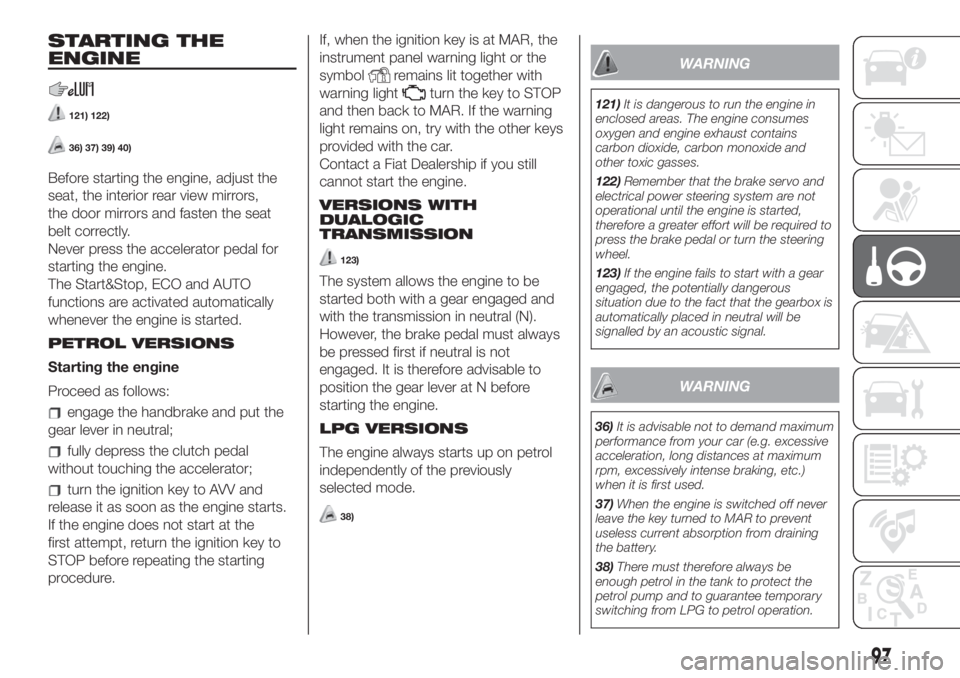
STARTING THE
ENGINE
121) 122)
36) 37) 39) 40)
Before starting the engine, adjust the
seat, the interior rear view mirrors,
the door mirrors and fasten the seat
belt correctly.
Never press the accelerator pedal for
starting the engine.
The Start&Stop, ECO and AUTO
functions are activated automatically
whenever the engine is started.
PETROL VERSIONS
Starting the engine
Proceed as follows:
engage the handbrake and put the
gear lever in neutral;
fully depress the clutch pedal
without touching the accelerator;
turn the ignition key to AVV and
release it as soon as the engine starts.
If the engine does not start at the
first attempt, return the ignition key to
STOP before repeating the starting
procedure.If, when the ignition key is at MAR, the
instrument panel warning light or the
symbol
remains lit together with
warning light
turn the key to STOP
and then back to MAR. If the warning
light remains on, try with the other keys
provided with the car.
Contact a Fiat Dealership if you still
cannot start the engine.
VERSIONS WITH
DUALOGIC
TRANSMISSION
123)
The system allows the engine to be
started both with a gear engaged and
with the transmission in neutral (N).
However, the brake pedal must always
be pressed first if neutral is not
engaged. It is therefore advisable to
position the gear lever at N before
starting the engine.
LPG VERSIONS
The engine always starts up on petrol
independently of the previously
selected mode.
38)
WARNING
121)It is dangerous to run the engine in
enclosed areas. The engine consumes
oxygen and engine exhaust contains
carbon dioxide, carbon monoxide and
other toxic gasses.
122)Remember that the brake servo and
electrical power steering system are not
operational until the engine is started,
therefore a greater effort will be required to
press the brake pedal or turn the steering
wheel.
123)If the engine fails to start with a gear
engaged, the potentially dangerous
situation due to the fact that the gearbox is
automatically placed in neutral will be
signalled by an acoustic signal.
WARNING
36)It is advisable not to demand maximum
performance from your car (e.g. excessive
acceleration, long distances at maximum
rpm, excessively intense braking, etc.)
when it is first used.
37)When the engine is switched off never
leave the key turned to MAR to prevent
useless current absorption from draining
the battery.
38)There must therefore always be
enough petrol in the tank to protect the
petrol pump and to guarantee temporary
switching from LPG to petrol operation.
97
Page 100 of 228

39)Never, under any circumstances, jump
start the engine by pushing, towing or
coasting downhill. This could cause fuel to
flow into the catalytic converter and
damage it beyond repair.
40)A quick burst on the accelerator before
stopping the engine serves no practical
purpose; it wastes fuel and is especially
damaging to turbocharged engines.PARKING THE
VEHICLE
When parking and leaving the car,
proceed as follows:
engage a gear (1stgear if facing
uphill or reverse if facing downhill) and
leave the wheels turned;
stop the engine and engage the
handbrake;
always remove the ignition key.
Block the wheels with a wedge or a
stone if the car is parked on a steep
slope.
Do not leave the ignition key on MAR to
avoid draining the battery. Always
remove the key when you leave the car.
Versions with Dualogic
transmission
To park safely it is essential to engage
1
stgear or reverse (R), with your foot on
the brake pedal and, if there is a
gradient, to operate the handbrake.
Before releasing the brake pedal, wait
until P appears on the display.
IMPORTANT NEVER leave the car with
the gearbox in neutral (or, on versions
equipped with automatic transmission,
before placing the gear lever at P).HANDBRAKE
124) 125) 126)
The handbrake lever fig. 74 is located
between the two front seats.
Handbrake engagement
To use the handbrake pull the lever
upwards until the car cannot be moved.
When the handbrake is on and the
ignition key is at MAR position, the
warning light
will appear on the
instrument panel.
Handbrake disengagement
Proceed as follows to release the
handbrake:
slightly lift the handbrake and press
release button A fig. 74;
press and hold button A and lower
the lever. The
warning light in the
instrument panel will go out.
74F0S0048
98
STARTING AND DRIVING